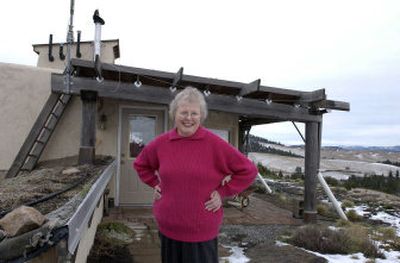Eco-building booms

Some people in the Spokane area worry about rising utility rates. Not Marilynne Mueller.
“The meter’s been going backward until just recently,” she said.
Mueller and husband, Joris, both 71, haven’t figured out a way to cheat the electric company – their Spokane Valley home, with its sophisticated insulation, passive solar heating and large array of photovoltaic panels, generates about twice the energy it needs in summer months. The power grid sucks up the extra juice, and Avista credits their account. When the skies turn dark in the winter, that account pays for whatever additional energy they draw.
Solar energy is only one of many unique features of the 1,650-square-foot home.
The walls are made of straw bales and the roof beams are logs salvaged after a storm. A solar chimney pumps heat from the sun into the ground, where it stays until winter, when it rises to provide warmth. The home is built into the side of a hill, and a layer of soil on the roof provides insulation and serves as an herb garden. Barrels collect rainwater for irrigation and a compost bin turns waste into fertilizer.
Besides being a good investment, the home reflects the couple’s earth-friendly ethos.
“We always felt we wanted not to take more from the world than we left behind,” said Marilynne Mueller.
Called “green building,” the concepts behind the Muellers’ home have been around for decades. Yet with energy prices reaching highs not seen since the 1970s, and concerns about global warming causing many Americans to rethink their carbon output, environmentally sensitive home design is coming back in a big way. The National Association of Homebuilders states that by the end of 2007 half of its members planned to incorporate some green practices in their building projects.
In the Spokane area, architects and builders see green building beginning to boom.
“It’s just exploded in the last two to three years, mostly because of what’s happening with the energy situation,” said Kelly Lerner, an architect and president of One World Design, which designs and remodels homes using green principles. “I think it’s the tip of the iceberg.”
While a large photovoltaic array like the one used by the Muellers can cost as much as $25,000, Lerner said that even those without deep pockets can build or remodel along environmentally friendly – and energy efficient – lines.
“It can certainly be done by the average Joe,” she said. “Good insulation, good windows, efficient design, small houses – it’s the wave of the future.”
Even in the Spokane area, a solar water system could take care of a home’s hot water needs from April to October, Lerner said. Designing to maximize sun exposure, purchasing energy-efficient appliances and installing “super-insulation” could cost $5,000 or less, money which could be recouped within only a few years. Solar panels, while expensive, are subsidized by both federal and state programs and can pay for themselves in as little as 10 years. What’s more, having a built-in energy source can boost the value of a home by thousands of dollars.
While high energy prices appear to be the main force behind the green boom, some Spokane families are choosing to pay more to reduce their impact on the earth.
Nathan Meyers, 32, runs a commercial flooring business in Spokane. His newly built home used Rastra – blocks of recycled Styrofoam and concrete – for its walls.
“The cost threw us off,” he said. “But it’s about conscience – are you building for tomorrow?”
The energy-efficient design of the home cost more than a conventional design, but that did not concern him, he said. “It’s going to cost more out of the gate, but you pick that up down the road,” he said.
“In the end, we’re really happy with it and we’re going to live in it forever,” he said.